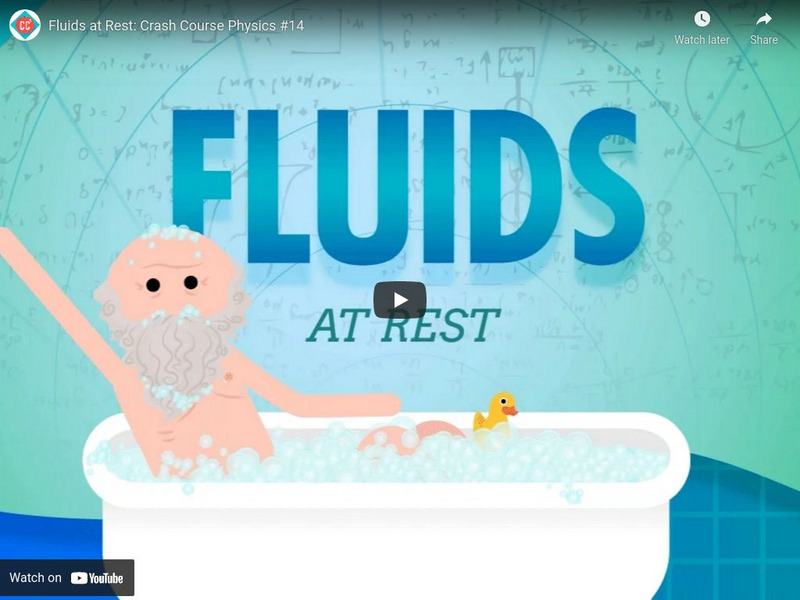Hi, what do you want to do?
Visual Learning Systems
Forces in Fluids: Pascal's Principle
Upon viewing the Forces in Fluids video series, students will be able to do the following: Define fluids as substances that can easily flow and readily change shape. Explain that fluids flow because particles can easily move past each...
Curated Video
Pascal’s Law Explained | Force Multiplication, Hydraulic Lift & Applications in Physics
Discover how Pascal’s Law makes it possible to lift massive weights with a small force! 🌊 This lesson explores the principle of pressure transmission in fluids, derivation of key formulas, force multiplication using pistons, and...
Visual Learning Systems
Forces in Fluids: Summing Up
Upon viewing the Forces in Fluids video series, students will be able to do the following: Define fluids as substances that can easily flow and readily change shape. Explain that fluids flow because particles can easily move past each...
Visual Learning Systems
Forces in Fluids: Fluids in Motion
Upon viewing the Forces in Fluids video series, students will be able to do the following: Define fluids as substances that can easily flow and readily change shape. Explain that fluids flow because particles can easily move past each...
SciShow
Fun With Potatoes & Physics! A SciShow Experiment
Hank uses a favorite subject of the YouTube community - the potato gun - to teach us about the principles of pneumatics, which use the potential energy of compressed gas to do work in lots of useful machines every day.
Visual Learning Systems
Forces in Fluids: Buoyancy and Density
Upon viewing the Forces in Fluids video series, students will be able to do the following: Define fluids as substances that can easily flow and readily change shape. Explain that fluids flow because particles can easily move past each...
Visual Learning Systems
Forces in Fluids: Introduction
Upon viewing the Forces in Fluids video series, students will be able to do the following: Define fluids as substances that can easily flow and readily change shape. Explain that fluids flow because particles can easily move past each...
Visual Learning Systems
Forces in Fluids: Fluids and Pressure
Upon viewing the Forces in Fluids video series, students will be able to do the following: Define fluids as substances that can easily flow and readily change shape. Explain that fluids flow because particles can easily move past each...
Visual Learning Systems
Forces in Fluids: Variations in Pressure
Upon viewing the Forces in Fluids video series, students will be able to do the following: Define fluids as substances that can easily flow and readily change shape. Explain that fluids flow because particles can easily move past each...
Visual Learning Systems
Forces in Fluids: Video Assessment
Upon viewing the Forces in Fluids video series, students will be able to do the following: Define fluids as substances that can easily flow and readily change shape. Explain that fluids flow because particles can easily move past each...
FuseSchool
Hydraulics
Hydraulics | Forces & Motion | Physics | FuseSchool What do water piston, cranes and car brakes have in common? They all have hydraulics to thank… which is the movement of liquids. In this video we’ll look at how hydraulics multiply...
Curated Video
Introduction to Finding Derivatives
This video explains the concept of finding the derivative or instantaneous rate of change for non-linear graphs by using the gradient of the tangent. The speaker demonstrates the process through examples and explains the general formula...
The School of Life
Philosophy - Blaise Pascal
Blaise Pascal's pessimism makes way for his readers' optimism, with his famous contemplative work, Pensées. High schoolers watch a short video that summarizes the historical philosopher's worldview and most popular aphorisms.
Physics Girl
Which Tank Fills First?
Can your class solve the riddle? A video from the Physics Girl playlist tackles the puzzle of Pascal's Principle. Viewers observe as a series of connected tanks fill up and try to guess which will fill first. The narrator shows the...
Crash Course
Fluids at Rest: Crash Course Physics #14
Keep the knowledge flowing in your physics classroom! An in-depth video lesson discusses the characteristics of fluids. The narrator includes Pascal's Principle and Archimede's Principle as well as buoyant force. This is the 14th lesson...
Bozeman Science
Properties of Matter
The properties of matter including buoyancy, viscosity, density, pressure, and more are explained in a video that also describes the various principles and laws that are associated with each property.
Khan Academy
Khan Academy: Pressure and Pascal's Principle (Part 1)
Sal explains the difference between liquids and gasses (both fluids). He then starts a calculation of the work done on a liquid in a U-shaped container. [9:46]
Khan Academy
Khan Academy: Fluids: Fluids (Part 2)
Pascal's Principal as it relates to pressure. [10:13]
PBS
Pbs Learning Media: Lifting With Air
How can you lift a heavy metal table using air? In this video segment adapted from ZOOM, cast members succeed in lifting a table using their own breath and a few plastic bags. [1:38]
Crash Course
Crash Course Physics #14: Fluids at Rest
In this video episode of Crash Course Physics, Shini is very excited to start talking about Fluids. You see, she's a Fluid Dynamicist and Mechanical Engineer, so fluids are really important to her. Actually, they're really important to...













